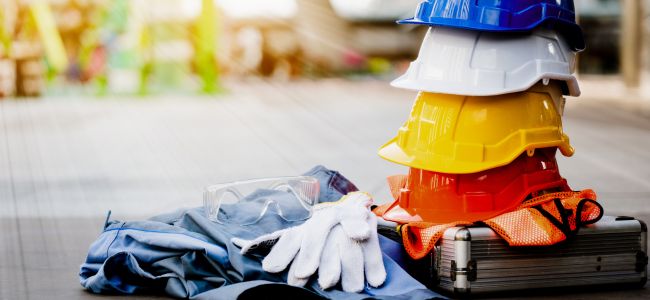The critical importance of safety in construction and PPE’s role in protecting workers.
The construction industry is a vital part of the global economy, responsible for building the infrastructure that shapes our everyday lives. In the United States alone, over 7.5 million people are employed in construction-related jobs. This significant workforce undertakes tasks that range from residential building to massive infrastructure projects. However, construction also presents numerous hazards, making safety a paramount concern. This article delves into the anatomy of safety in construction, emphasizing Personal Protective Equipment (PPE), as well as revealing the biggest occupational dangers and the importance of safeguarding workers.
Construction Safety’s Scale
So how many people work in the U.S. construction industry? According to the Bureau of Labor Statistics, the construction industry in the United States employs over 7.5 million individuals. This substantial workforce is engaged in a variety of tasks, including residential, commercial, and industrial construction. The sheer number of workers highlights the importance of implementing comprehensive safety measures to protect them from the numerous hazards they face daily.
The Biggest Dangers in Construction
Construction sites can be inherently dangerous environments, with a myriad of potential hazards that can lead to serious injuries or fatalities. Some of the biggest dangers in construction include:
- Falls: Falls are the leading cause of fatalities in the construction industry. Workers often perform tasks at significant heights, making fall protection measures crucial.
- Struck-By Incidents: These occur when workers are hit by moving vehicles, falling objects, or equipment. Proper training and the use of PPE can mitigate these risks.
- Electrocution: Contact with live electrical wires and equipment can result in severe injuries or death. Ensuring proper insulation and adherence to safety protocols is essential.
- Caught-In/Between Incidents: These involve workers being caught in or compressed by equipment or objects. Awareness and the use of protective devices are vital in preventing such accidents.
Statistics on Injuries in Construction
The construction industry has one of the highest rates of workplace injuries and fatalities. According to the Occupational Safety and Health Administration (OSHA), in 2023, approximately 1 in 5 worker deaths occurred in construction. Furthermore, non-fatal injury rates are also alarmingly high, with common injuries including sprains, strains, fractures, and lacerations.
In 2023, there were 1,034 fatal injuries in the construction industry.
- Falls accounted for 370 of these fatalities.
- Struck-by incidents resulted in 120 deaths.
- Electrocutions caused 85 fatalities.
- Caught-in/between incidents led to 55 deaths.
These statistics underscore the critical need for stringent safety measures to help protect construction workers from harm.
The Role of Personal Protective Equipment
PPE is not just about individual pieces of equipment; it’s about fostering a culture of safety where every worker understands the importance of using these protections consistently and correctly. Training and education are paramount in ensuring that workers not only wear PPE but also understand how to use it effectively. The proper use of PPE can significantly reduce the risk of injury and death, providing a last line of defense when other safety measures fail. Here’s how each category of PPE contributes to worker safety:
- Head Protection: Hard hats are designed to absorb impact and protect the skull from injuries caused by falling objects or overhead hazards. They can also offer electrical insulation for those working near live wires. It’s vital to select the proper class of helmet for the tasks at hand. Vented (Class C) helmets provide vents as a cooling feature, but non-vented (Class-E) offer additional insulative protection. Type II helmets offers added protection for side-impact when you are in especially dangerous zones on the job site. New material advancements in helmets are also helping to reduce trauma. For example, the use of Non-Newtonian foam or specialty fabrics aid in impact absorption.
- Hand Protection: Gloves protect hands from sharp objects, chemicals, and rough materials. They are essential for tasks such as handling tools, lifting materials, and working with hazardous substances. Advancements like QR codes printed directly on the cuff of a glove can help ensure chemical exposure is limited, and that you have the right glove for the job.
- Hearing Protection: Prolonged exposure to loud construction noises can lead to permanent hearing loss. Earplugs and earmuffs help reduce noise levels, protecting workers’ hearing. Dispensers are a great visual reminder to gear up on your hearing protection before leaving the job trailer. If you’re having a hard time fitting an employee with the right earplug, try fit testing, or consider an earmuff, which may offer multi-position or helmet attached options.
- Fall Protection: Safety harnesses and lanyards are crucial for workers operating at heights. These devices secure the worker and help prevent devastating falls, which are a leading cause of fatalities in the industry. You should also consider things like fall clearance when choosing between SRLs or PFLs and shock-absorbing lanyards. Check out some helpful tips in the ABC and Rs of Fall Safety.
- Footwear: A good trustworthy pair of work boots can make a huge difference in productivity.
Safety boots with steel toes and slip-resistant soles protect feet from crushing injuries, punctures, and chemical spills. They also provide stability and support, reducing the risk of slips and falls.
The construction industry’s dynamic and hazardous environment necessitates a strong focus on safety to protect its workforce. By understanding the biggest dangers in construction, implementing comprehensive safety measures, and ensuring the proper use of Personal Protective Equipment (PPE), we can significantly help reduce the risk of injuries and fatalities.
By: The Anatomy of Safety in Construction — Occupational Health & Safety






